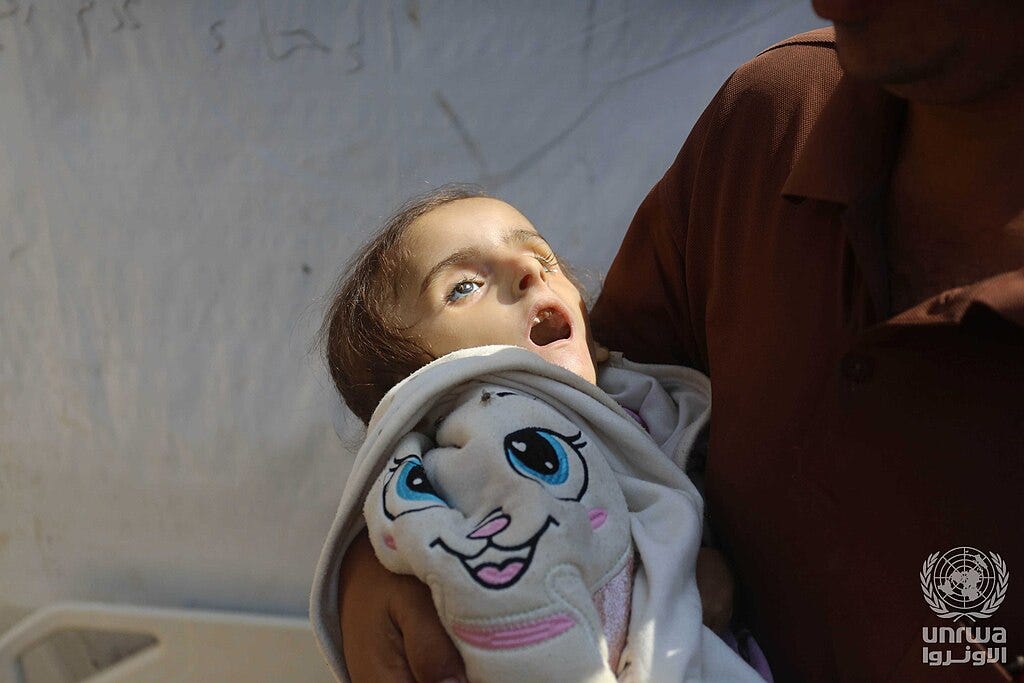Famine has been confirmed in Gaza City and surrounding districts by the UN backed Integrated Food Security Phase Classification. The thresholds are met. Households lack food, acute child malnutrition is widespread, and people are dying of hunger. The finding lands after months of warnings and after years of policies that made Gaza one of the most tightly controlled territories on earth.
The cause is the siege. Israel has controlled Gaza’s borders, airspace, and sea access for years and tightened those controls during the war. Fuel and electricity were cut or rationed. Aid convoys were delayed or turned back. Crossings opened and closed with little notice, leaving trucks idling while stocks ran out inside. Strikes and ground operations damaged or destroyed cropland, irrigation, mills, ovens, markets, warehouses, roads, and water infrastructure. Fishing has been banned along Gaza’s coast, removing one of the last local sources of protein and income. When bakeries could not get flour or fuel, neighborhoods lost their only reliable calories. When roads were cratered, relief trucks could not move. When fuel ran dry, pumps and hospitals stopped. The result is a man made collapse of the systems that keep civilians alive.
In May the UN led aid distribution system was sidelined and replaced by the Gaza Humanitarian Foundation. Its distribution points are run under armed oversight and have become kill zones. Rights groups, doctors, and journalists have documented people shot while queuing for food and surges of gunshot wounds on delivery days. Families describe sprinting through choke points where live fire cracks over their heads and where panicked crowds trample the weakest. Rebranding these sites as humanitarian does not change what happens there. People go to eat and they come home wounded or do not come home at all.
"Kill Zones": Israeli Soldier Admit Gaza Areas Are Free-Fire Zones for Civilians
Testimony from an Israeli soldier and reports from multiple human rights groups confirm that the Israel Defense Forces (IDF) have deliberately transformed large swaths of the Gaza Strip into so-called “kill zones” — areas where any person, regardless of age or affiliation, is considered a legitimate target.
Hospitals report children arriving with severe wasting and complications that turn minor illness into a fatal chain. Parents describe days without food. Aid groups say hundreds of thousands are at catastrophic levels of hunger and that conditions are spreading south from Gaza City into Deir al Balah and Khan Younis. UN agencies have said repeatedly that predictable access and fuel are the difference between a humanitarian operation that feeds a population and a photo opportunity that does not.
Under international humanitarian law, starvation of civilians as a method of warfare is prohibited. That standard exists to prevent exactly what is happening now. The pattern in Gaza is consistent and documented. Restrictions on food, fuel, and medical supplies, combined with the destruction of distribution networks, produce famine even when warehouses stand a short drive away. The evidence is visible in shipping logs, crossing statistics, convoy permissions, and the growing count of malnutrition deaths.
Officials in Israel reject the accusation that policy choices produced famine and point to security concerns and aid diversion. The numbers tell a different story. The volumes that entered were not enough for the population size, the deliveries were unpredictable, and the networks needed to turn shipments into meals were broken. Airdrops and sporadic passages did not change that equation.
Famine in Gaza is the foreseeable outcome of prolonged blockade and intensified wartime restrictions. It is the predictable end point of cutting fuel, stopping trucks, damaging water and food infrastructure, and limiting the movement of aid workers. The declaration formalizes what families have been living for months. Gaza is starving because it was made impossible to feed it.




